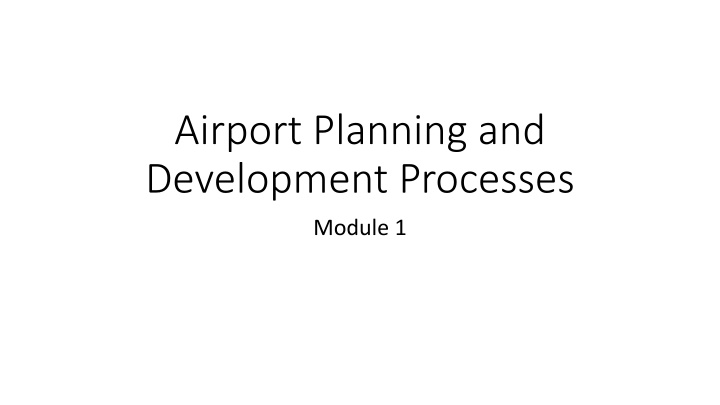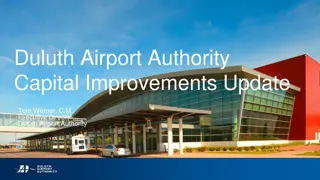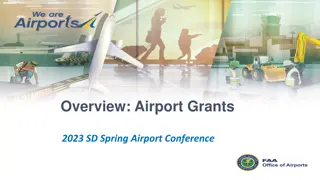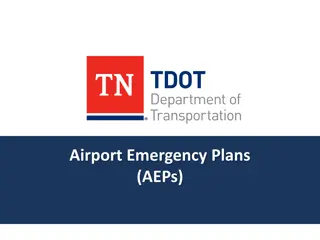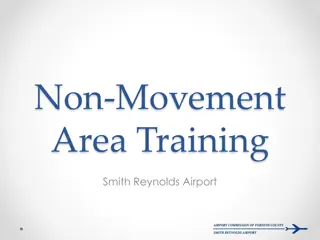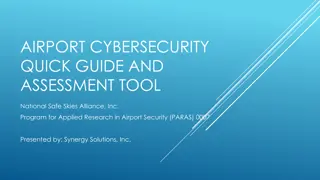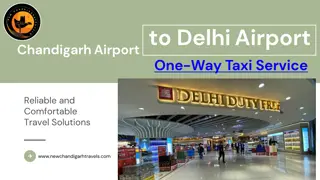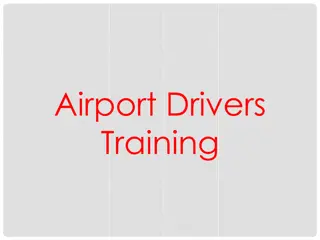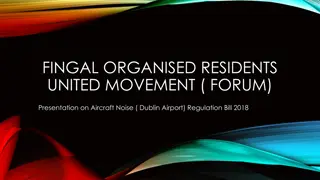Airport Planning and Development Processes: Understanding System Interactions
Planning an airport involves careful consideration of its role within the larger aviation system. Learn about aviation system planning, components, and levels of planning to ensure the harmonious development of airports. Discover the importance of subsuming airport planning into comprehensive aviation system planning for optimal long-term structures and performance.
Download Presentation

Please find below an Image/Link to download the presentation.
The content on the website is provided AS IS for your information and personal use only. It may not be sold, licensed, or shared on other websites without obtaining consent from the author.If you encounter any issues during the download, it is possible that the publisher has removed the file from their server.
You are allowed to download the files provided on this website for personal or commercial use, subject to the condition that they are used lawfully. All files are the property of their respective owners.
The content on the website is provided AS IS for your information and personal use only. It may not be sold, licensed, or shared on other websites without obtaining consent from the author.
E N D
Presentation Transcript
Airport Planning and Development Processes Module 1
Airport Planning The airport is one node in a larger system. The planning of the airport has to carefully consider its role, function, and interaction within the entire system. Neglecting to do so will adversely impact its future development. It is therefore important to understand the relationship between the airports within the system, their planning, and ways to harmonize the planning of the airport within its system and with the larger aviation system and other interacting systems.
Aviation System Planning Aviation system planning is a process aimed at translating goals and policies into programs that would guide the evolution of the aviation system. The process is a continuous one and it includes monitoring the development of the system and replanning its evolution. It should be a comprehensive one due to the sheer number of entities in the interacting systems. It should also be a coordinated process in order to have all parties and stakeholders of the systems involved interactively in their planning. The aviation system planning process covers national and state systems and can be applied to components of other systems or subsystems.
Aviation system components and subcomponents Airways Operating system Airports Airlines Aircraft Air passengers Air cargo
Ideally, the planning of the airport system should be subsumed into an aviation system planning exercise. In practice, this may not be feasible in certain countries, as the system would be very large and sophisticated, system components may not be well developed or even exist, advanced technology required is not available, or the country lacks the institutional and constitutional make-up. Only in a developed country with the above components established and mature can a comprehensive, continuous, and coordinated aviation system planning be applied.
Levels of planning Strategic Level. At this level long-term structures are examined and the adequacy of various structures and system interactions is determined to assess how well they fit the identified goals and objectives. It is at this level where procedures, timelines, and interaction modalities are set out that will lead to an optimum long-term plan with an ideal structure for the system and its future performance.
Tactical Level. At this level short- and medium-term courses of action are examined and the plan that would best fit the overall strategic goals is determined. The plan would include tasks, procedures, timelines, entities involved, and the particular courses of action in the short and medium terms. Project Level. This level identifies details of executing a tactical plan to carry out a well-defined project of a specific nature and clear objectives. The plan would explicitly state its components, including the timeline, the budget, management procedures governing interaction between parties, and the specific outcome of the plan.
3C Planning process Continuing: Planning must be maintained as an ongoing activity and should address both short-term needs and the long-term vision for the region; Cooperative: The process must involve a wide variety of interested parties through a public participation process; and Comprehensive: The process must cover all modes and be consistent with regional and local land use and economic development plans.
These three planning levels can be applied to an idealized 3C planning structure for aviation system planning and airport system planning. Planning levels that start from a national strategic aviation system plan, to a tactical airport system plan, and then to a project-level airport master plan represent the best approach to guarantee that the airport development will consider all aspects of the aviation system. While the airport system plan is strategic in nature, it is actually tactical in context. It is a process designed to optimize and harmonize the role of individual airports for best system performance. It is also designed to provide public funds to all airports, considering what each needs to perform adequately in the medium term as well as to ultimately maintain an efficient national airport system.
The airport master planning process is multifaceted and brings strategic and tactical planning perspectives to a project the airport. It is strategic in that the plan is long term vis-a-vis the airport s ultimate role in the system. It is tactical in that it specifies` short- to medium-term steps the airport is required to take to reach the strategic goals of the aviation and airport system plans. The master plan is, after all, a project-level plan to determine specific development phases the airport is required to undertake to reach its ultimate goal.
Planning Airport System Under Different States of Industry National economic and political landscape, stakeholders perceived outlook of the systems, as well as technological changes and advancements in the industry and their collective impacts on the planning process. These scenarios are dependent on government monopoly and laws dictating all activities in the system and an unregulated, deregulated, liberalized environment where all elements in the system play by the rules of the free market economy and promote privatization. The scenarios to be examined include: 1. Government-regulated monopoly 2. Deregulated free market 3. Public private partnership (PPP) 4. Global partnership with foreign enterprise
Government-Regulated Monopoly Lack of innovation and development of new ideas or new technology Lack of risk taking by civil servants with no motivation to enter into courses of action with uncertain outcomes A career structure for professionals which bases advancement on length of service and not performance Inadequate response to the needs of clients or customers, that is, the airlines or passengers
Government regulations on the air transport industry resulted in: Limited access to medium to small markets and communities. Airline competition was minimal and had no impact on entering new markets or on airfares that were preset by government Most air transportation activity was concentrated in the primary airports, The existence of international gateways where international flights served few airports
Deregulated free market The free market approach was considered by its proponents to have several overall advantages: Access to finance in the normal commercial financial markets Introduction of competition, bringing lowest costs to passengers and maximum service levels A market-driven approach, with management objectives responsive to passenger consumerism.
Opponents of airline deregulation presented a number of potential problems: Airlines have no long-term commitment to either routes or airports, which brings an inherent instability to the system. The system can be subject to very large changes in transport supply, in terms of airline provision, at very short notice. There has been a tendency toward the development of a few very large mega carriers rather than many smaller and highly competitive operations. Small carriers have found themselves subject to predatory competition. Most airports are small corporate and financial entities in comparison with airlines. They find themselves subject to great pressure to conform to the airlines requirements. Airports which are entirely privatized can have goals which are not aviation oriented and which, furthermore, may conflict directly with aviation needs. The transfer of the airport public authority to private ownership entails the transfer of large amounts of sunk public capital and assets, the value of which on the open market is almost impossible to assess correctly. The private entities are prime targets for asset stripping, takeovers, and non-aviation- oriented management.
Airline Hubs and Deregulation The benefits to all of airlines that adopted hubbing include: Air access benefits to the residents of hub cities, which are usually the larger metropolitan areas and business centers. Enhanced international service to the hubs and to the many airports serving as their spokes, bypassing traditional international gateways. Enhanced domestic service to small cities that as spokes to the airline hubs provided far improved service over the previous point-to-point system. Competition between hubs (actually between airlines) would bring greater benefits to smaller communities through a wider choice of carriers, more service frequency with convenient connections, and perhaps more reasonable airfares.
AIR TRANSPORT PLANNING IN INDIA EXTERNAL FACTORS International prices of ATF, is the single most important factor that affects the cost of air operations. Marketing and pricing policies of Indian Oil Companies too have a snowballing effect on costs. Global health issues As environmental factors assume global importance, laws and policies related to environment protection would play an increasing role in Civil Aviation operations affecting both airlines as well as airports Growth of alternative modes of transport also affects the overall health of the sector. Development of new technologies has a tremendous effect on Aviation specially in the field of Air Traffic Management, Meteorology, Ticketing etc.
EXTERNAL FACTORS The performance of the sector also depends upon tax policies of the Government like service tax etc on passengers and flying schools and imposition/exemption of customs duty on import of aircrafts and spares. FDI Policy of the Government is a major determinant in the growth of the sector. Land Acquisition and Rehabilitation Policies of the Government of India as well as State Governments radically affects the growth of infrastructure facilities specially airports. Policies of the Ministry of Defence in sharing Air Space and Aerodromes are a critical factor in Indian Aviation. Promotion of India as a tourist destination will impact the international passenger traffic to India.
INTERNAL FACTORS The manifesto of the government and the strategic priorities at the time Availability of budgets in line with the strategic plans Organisational culture and availability of skilled personnel Rigid and slow recruitment processes Acceptance and deployment of automation is lower than desired Organisational procedures have not been reviewed for a long period of time
STAKE HOLDERS AND THEIR INTERESTS Stakeholders ranging from passengers to vendors of high and strategic technologies. The most important stake holder in the sector is the common passenger, needs affordable, comfortable and safe travel with a decent quality of customer services. Pilots, crew members and technicians of civil aviation. We need to ensure continued training and adoption of high standards of safety in operations in order to support this group. Airline Operators, both SOP as well as NSOP, are the basic service providers and hence the growth and performance of the sector is substantially dependent upon them. Their expectation is to operate in a liberal laissez-faire environment where fair competition is allowed to thrive with minimal Govt. Controls. constitute the backbone
Airport operators and managers of aviation infrastructure are critical in the growth of the sector. Their interest is in ensuring the safety, security and commercial viability of the airports that they operate. Defence Ministry in an important stake holder as it manages a large number of airports in the country which are also used for civilian operations. The Ministry also shares a large part of the Indian air space and hence determines the scale of civil operations. We are required to maintain the primacy and priority of military needs in terms of use of airspace, infrastructure and operating procedures followed. Ministry of Environment is an important player because Civil Aviation has a significant effect on environment through noise and effluents. Regulatory Service Providers like the CISF The Ministry of Home has a vital role to play in civil aviation due to security reasons. They also provide vital intelligence inputs to handle security issues. MRO - Their needs relate to R&D, easy import of technology and availability of trained human resource. Training Schools Civil aviation operations depend heavily on efficient ground handling. The ground handling agencies thus are a significant player in the system.
Oil Marketing Companies Ministries of Finance Ministry of Urban Development and Municipal Agencies provide the approach infrastructure to airports. They control the access to the services and hence are a major contributory factor in the growth of the sector. They also control the growth of habitations near airports and the implementation of building regulations which effect air movements. The Air Traffic Controllers who manage the air traffic are important both for optimal utilisation of air space as well as safety of operations. The Ministry of Science and Technology is in the process of developing a 70-90 seater civilian aircraft capable of 1000-2000 km flying. Ministry of Communication who conduct wireless examinations for Indian pilots are an important stake holder, they also provide wireless connectivity which is critical to air traffic management. Manufacturers of Aircrafts and engines provide the basic hardware of the industry. They provide direction and pace through their marketing strategies and development of technology. They are impacted by taxation issues prevalent at the time.
CONNECTIVITY Connecting un-served and under-served areas through increase of airport infrastructure Last mail connectivity by creating a mechanism to integrate the larger airports with smaller airports in the region Cost of travel - the Government would develop suitable regulatory mechanisms to prevent predatory/ oligopolistic practices. Create the right infrastructure for the rapid growth of helicopter operations. excessive charging and
AVIATION INFRASTRUCTURE AIRPORTS Development of Airports would be guided by the following principles: District level airport with population less than 2 lacs should have the facility to cater for aircraft having seating capacity of 30 seats, Aerodrome reference code 2B Tourist/pilgrimage centres should have the facility to cater for aircraft having seating capacity 30 to 80 seats, Aerodrome reference code 3C State Capital Airport should have the facility to cater for aircraft having seating capacity 80 to 200 passengers, Aerodrome reference code 4C Non-metro international airports facility to cater for aircraft having seating capacity 250 & above, Aerodrome reference code 4E Special requirement of air connectivity to NE region, J&K, A&N islands, Lakshadweep islands as socioeconomic commitment. Development of heliports for air connectivity through helicopter services in remote areas in J&K, M.P, Chattisgarh, Orissa, A.P, Gujarat etc. should have the
Airport Development models By AAI By Central Government/ State Government/ NEC By Public Private Partnership (PPP) model AAI/ Operator to be permitted to utilize the land on city side, to earn revenue as well as to permit levy of ADF/ UDF All Non operational AAI or state Govt airports and All Greenfield airports can be developed through PPP model and BOOT scheme. The development includes terminal building, airside as well as city side To bridge the viability gap, private consortium/ investor be permitted to utilize the excess land on city side to earn revenue as well as to levy UDF/ADF CNS/ ATM facilities to be provided by AAI
Constraints Faced Project stage Challenges Description Planning Financial Attractiveness of airports in Tier II/III towns Airport projects are capital intensive with long gestation periods There is much higher certainty of returns from airports in metros/large cities, than from smaller cities/towns even though the capital cost is extremely different It is therefore easier to attract private sector players and also secure financial closure for the larger projects but the country s need is now shifting towards smaller airports Land acquisition Airports require significant land; which is complex and time consuming to acquire despite the presence of many attractive compensation schemes which exist today Environmental Issues There is an overall increase in concern about environmental issues. However, compliance can be a time consuming process
Project stage Challenges Description Several of the airports in the country are making operational loss, putting a drain on resources We need to find ways of addressing this issue Post commissioning Financial feasibility Encroachment and building Violations Despite a clear legal framework, operations continue to suffer due to encroachment and violation of building codes. This reduces the efficiency and effectiveness of the airports
Addressing the Constraints Corporatisation of AAI Strengthen marketing capabilities of AAI Improved development and use of retail opportunities Joint initiatives with tourism players (government and private) to create packages and promote a destination incentives for usage of airport Develop alternate funding options Assess the feasibility of developing low cost airports
AIR NAVIGATION SERVICES The primary objective of Air Traffic Management is to: Develop an ATM system that ensure optimum safety to the aviation industry Provide the airspace users the desired level of operational efficiency to achieve cost effective operations through Ensure Safe, Efficient and cost effective operations, minimise delays and enhance capacity. Increased utilisation of existing capacity Flexible use of Airspace for ensuring smooth flow of traffic without undue restrictions Improved use of ground infrastructure Load sharing among nearby airports
CARGO Creation of Cargo Terminal Infrastructure AAI will consider the development of Cargo Terminals at Pune, Sri Nagar, Guwahati, Chandigarh, Surat, Mangalore and Trichy in next 5 to 10 years. Automation and governance Integrated Facilities: AAI shall develop Cargo Villages Shall look to set up customs free zone within airport premises with permission of Customs Authorities Faster processing of non courier express shipment by providing separate area in cargo terminal
MAINTENANCE AND REPAIR ORGANISATION (MRO) An MRO is a critical element of aviation infrastructure Currently, airlines in the country are being required to send their crafts overseas for several maintenance activities. Plan with the global market in mind Ensuring a world-class facility Ensure price competitiveness Develop HR capabilities as required
E-GOVERNANCE HUMAN RESOURCE
